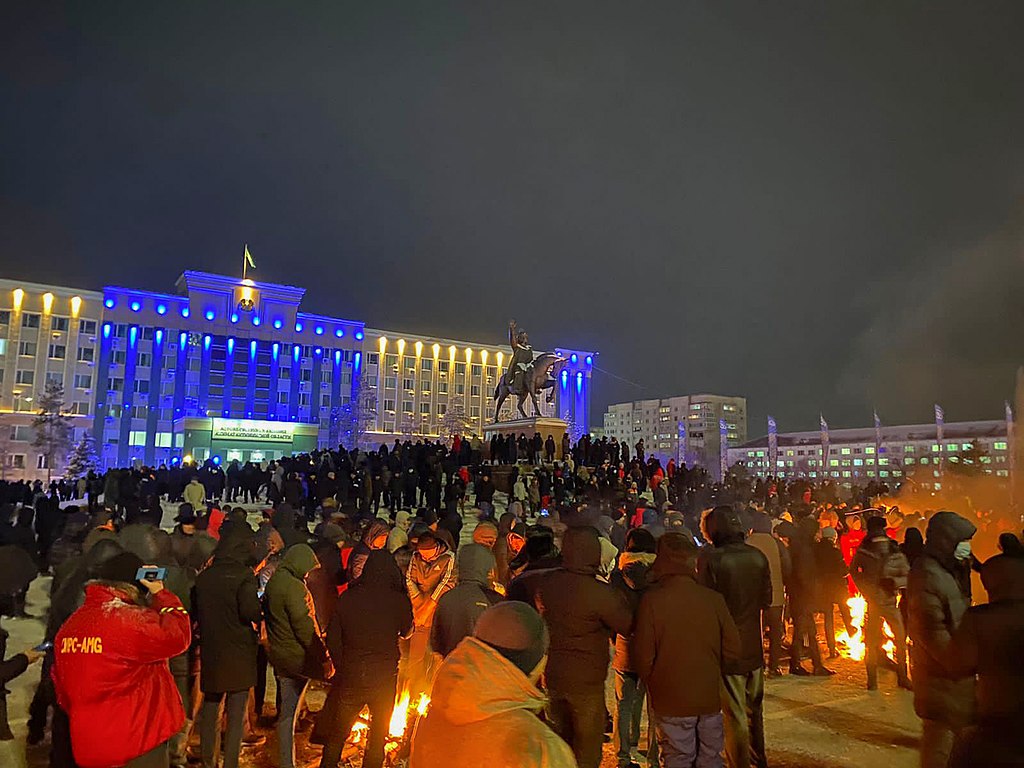Almaty, Kazakhstan —(Map)
After a week of protests and a violent crackdown, Kazakhstan appears to have become calm. But the events of the last week have changed Kazakhstan’s image as a stable country, and raised many questions about its future.

(Source: Esetok [CC BY-SA 4.0], via Wikimedia Commons.)
Kazakhstan Background
Kazakhstan is a very large country to the south of Russia and west of China. Until 1991, Kazakhstan and Russia used to both be part of the same country – the USSR. For years, Kazakhstan has been seen as a stable country with good relations with Russia, China, and the United States.
In 2019, Nursultan Nazarbayev, who was president of Kazakhstan for 30 years, stepped down suddenly. Mr. Nazarbayev was a tough ruler, and kept the country under tight control.
Even though Mr. Nazarbayev was replaced as president by Kassym-Jomart Tokayev, many people think Mr. Nazarbayev has still been secretly helping control the country.
On January 2, protests broke out in western Kazakhstan following a sudden rise in fuel prices. Protests are very unusual in Kazakhstan. But when the government stopped limiting the price of the special fuel most people in Kazakhstan use for their cars, the price doubled overnight. People were very upset.
The first protests were in Zhanozen, an oil-producing city. Many people felt the price increases were unfair, since Kazakhstan makes lots of money selling oil and gas to other countries.
😕
This image has not been loaded because of your cookie choices. To view the content, you can accept 'Non-necessary' cookies.
As the protests spread, the demands of the protesters changed. Police fired tear gas to break up the protests. But President Kassym-Jomart Tokayev also made some changes the protesters wanted. Above, protesters in Almaty on January 4.
Soon, protests with tens of thousands of people took place in cities across the country. As the protests spread, the demands of the protesters changed. Protesters wanted more political freedom and new elections.
Police fired tear gas to break up the protests. But President Kassym-Jomart Tokayev also made some changes the protesters wanted. He dismissed the prime minister and his cabinet. He also promised to lower fuel prices for six months.
As the protests continued on Wednesday, some protesters became more violent. Some tried to take over important buildings, and the country’s main airport. Several government buildings were set on fire.
😕
This image has not been loaded because of your cookie choices. To view the content, you can accept 'Non-necessary' cookies.
As the protests continued on Wednesday, some protesters became more violent. Some tried to take over important buildings, and the country’s main airport. Several government buildings were set on fire. Above, the mayor’s office was set on fire in Almaty.
Mr. Tokayev declared a two-week state of emergency. Internet service was limited to make it harder for protesters to organize.
On Wednesday, Mr. Tokayev asked for help from the CSTO (Collective Security Treaty Organisation). The CSTO is a Russian-led agreement between several countries to help defend each other.
In a speech carried on TV, Mr. Tokayev claimed many of the protesters were from outside the country. He called the protesters “bandits and terrorists“, and told security forces to “shoot to kill, without warning”.
😕
This image has not been loaded because of your cookie choices. To view the content, you can accept 'Non-necessary' cookies.
President Kassym-Jomart Tokayev declared a two-week state of emergency. On Wednesday, Mr. Tokayev asked for help from Russia. He called the protesters “bandits and terrorists”, and told security forces to “shoot to kill, without warning”. Above, Mr. Tokayev in 2019.
Around 3,000 soldiers arrived on Thursday from Russia and other countries. There were serious conflicts between security forces and protesters on Thursday and Friday. At least 26 protesters and 18 members of the security forces were killed. Some reports say that far more people died. Around 5,800 protesters have been arrested.
Some people believe last week’s events may be signs of a power struggle. On Wednesday, Mr. Tokayev removed Ex-President Nursultan Nazarbayev as the head of Kazakhstan’s Security Council. On Saturday, Karim Massimov, who was once the country’s prime minister, was arrested, suspected of treason. Some reports suggest that much of the violence may have been the work of a violent group of people who joined the protests.
😕
This image has not been loaded because of your cookie choices. To view the content, you can accept 'Non-necessary' cookies.
Around 3,000 soldiers and military equipment arrived on Thursday from Russia and other countries. Above, Russian military equipment ready to be flown to Kazakhstan on January 6. Image: Russian Defense Ministry Press Service
The protests seem to have stopped, but they have left Kazakhstan greatly changed. It’s not clear how much power Mr. Nazarbayev still has. Many people believe Mr. Tokayev now owes Russian President Vladimir Putin a huge favor for his help in getting the protests under control.
Russia, which has recently seemed to be preparing to invade Ukraine, now finds itself in a complicated situation, because it is also trying to support Kazakhstan’s government. Finally, many of the problems which started the protests haven’t really changed.
😕
This map has not been loaded because of your cookie choices. To view the content, you can accept 'Non-necessary' cookies.
